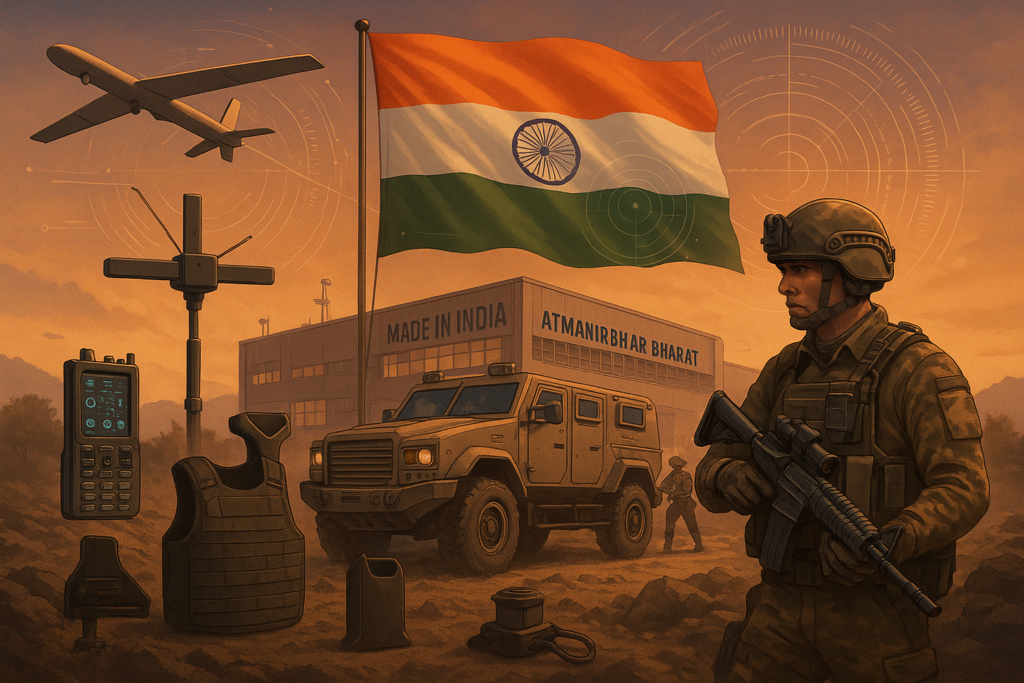
- The emergency defence purchase of ₹2,000 crore is one of the biggest fast-track procurement projects undertaken by the Ministry of Defence, Government of India.
- Interestingly, over 90% of this purchase was made from Indian local companies.
- By assigning the lion’s share of contracts to Indian firms, the Ministry of Defence has shown that it has complete faith in local capabilities.
- Essentially, this is not merely a procurement; it is a policy change, a strategic declaration, and a move towards a safer, independent, and technologically capable India.
Realistically valued at ₹1,981.90 crore, the emergency defence purchase of ₹2,000 crore is one of the biggest fast-track procurement projects undertaken by the Ministry of Defence, Government of India. It was carried out by the Fast Track Procedure (FTP), a unique clause designed to speed up the acquisition of strategic defence equipment when operational exigencies demand instantaneous capability augmentation. The Indian Army and paramilitary forces will specifically benefit from this procurement by receiving cutting-edge, mission-critical technology that will increase their effectiveness in border security, counterterrorism, and counterinsurgency operations.
The acquisition includes a wide range of equipment, such as mine-protected vehicles, anti-drone jammers, thermal sights, advanced reconnaissance and surveillance drones, loitering weapons (also known as kamikaze drones), bulletproof jackets, and battlefield secure communication systems. These technologies are especially valuable in asymmetric warfare operations where quick reaction, intelligence, and accurate strikes are crucial, in addition to being required in conventional operations. Interestingly, over 90% of this purchase was done from Indian local companies. Both state-owned companies, such as Bharat Electronics Limited (BEL) and Bharat Dynamics Limited (BDL), and commercial defence technology companies, including Mahindra Defence Systems, Idea Forge Technology, Tonbo Imaging, and Paras Defence and Space Technologies, have received the orders.
One Step toward Strategic Long-Term Independence
This procurement in an emergency is more than a tactical move—it is a move towards an autonomous defence system. By assigning the lion’s share of contracts to Indian firms, the Ministry of Defence has shown that it has complete faith in local capabilities. This strategy forms the basis for a defence industry that is both export-oriented and innovation-led, catering to national requirements as well as global demand. It promotes partnership among the military, domestic manufacturers, and research centres—a strong pipeline of cutting-edge, mission-focused technologies.
In addition to fulfilling near-term needs, the move makes one thing explicitly clear: India is determined to wean itself from foreign dependence and establish itself as a technologically superior, strategically independent military force. The initiative fortifies not just combat preparedness but also the long-term vision of the country to emerge as a defence production hub on the global map.
A Big Boost for Indian Defence Manufacturers
This procurement cycle’s heavy emphasis on domestic production is one of its most distinctive characteristics. Indian companies have been granted over 90% of the contracts. This is a major affirmation of the potential of both commercial defence entrepreneurs and public sector initiatives.
Defence Equipment Budget Analysis

Fast Track Procedure and Ground Operation Impact
The ₹2,000 crore emergency defence purchase was made under the Fast Track Procedure (FTP)—a system developed by the Ministry of Defence for rapid procurement of crucial military hardware in crises. Sparked by escalating border tensions and terrorist threats, FTP ensures speedy delivery, usually in 6 to 12 months, without compromising on quality. In contrast to traditional procurement, which is a lengthy process lasting years, the FTP accelerates the timeline without sacrificing dependability. Every system is tested extensively for battlefield capability, compatibility in operations, and technical robustness. This model showcases India’s transition to agile, accountable, and mission-capable defence governance.
The effect of this procurement on operations will be keenly felt and visible. The precision-strike drone and optical sights will allow for threats to be neutralised more precisely and with less exposure. Bulletproof vests, helmets, and mine-protected vehicles will enhance the survivability of troops in high-threat zones such as areas of insurgency and border areas.
Sophisticated surveillance, unmanned aircraft vehicles and thermal imaging equipment will enhance intelligence collection, especially in the low-visibility environment and hilly terrain. Protected communication networks will provide real-time connectivity between units and command posts to facilitate enhanced decision-making in combat. Notably, combat simulators to be procured will improve troops’ readiness through providing realistic training facilities that replicate real battle environments. Effectively, the FTP not only hastened procurement but also gave Indian forces a strategic advantage. The initiative enhances firepower, defence, mobility, and readiness, making the force more capable of confronting contemporary and unconventional warfare confidently.
Conclusion
India’s ₹2,000 crore emergency defence procurement is not just a swift reaction to changing security threats; it is a planned and foresighted investment in the country’s military preparedness and industrial robustness. By provisioning the military with cutting-edge equipment, going from loitering munitions and secure comms to anti-drone systems and advanced protection gear, the government has plugged immediate tactical shortfalls while at the same time setting the stage for long-term strategic dominance.
This acquisition also communicates a powerful message: India is no longer willing to rely on foreign vendors for its vital defence requirements. With more than 90% of the contracts given to Indian companies, the program demonstrates a clear turn towards self-dependence, innovation, and national capacity-building in defence production. It is in line with the Atmanirbhar Bharat vision, where the nation not only defends its borders but also creates a strong, export-driven military-industrial complex. Through its use of the Fast Track Procedure, the Ministry of Defence has demonstrated that it is possible to procure quickly and responsibly, getting our soldiers what they need when they need it, without sacrificing quality or operational standards. Essentially, this is not merely a procurement; it is a policy change, a strategic declaration, and a move towards a safer, independent, and technologically capable India. This successful emergency purchase sets a new precedent for how India protects its sovereignty: with urgency, accuracy, and belief in itself.
References:
- https://www.pib.gov.in/PressReleasePage.aspx?PRID=2139102
- https://www.business-standard.com/external-affairs-defence-security/news/indian-army-emergency-procurement-counter-terrorism-2000-crore-defence-deals-125062400764_1.html
- https://bharatshakti.in/defence-ministry-approves-rs-2000-crore-emergency-procurement-to-boost-armys-counter-terror-capabilities/#google_vignette
Piyush Anand is a Biotechnology Engineering student at Chandigarh University. His primary interest lies in International Affairs, Defence and Strategy. Views expressed are the author’s own.
